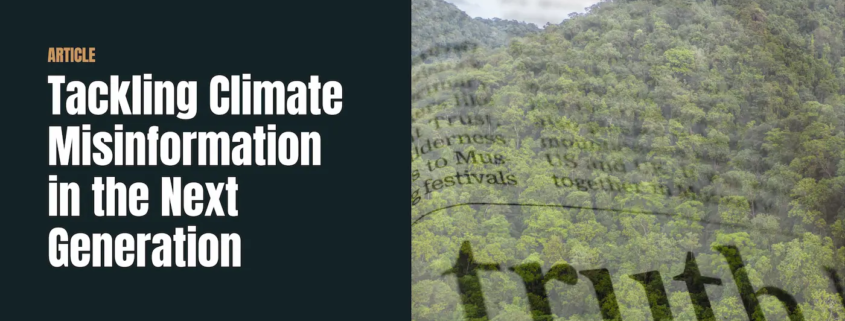Tackling Climate Misinformation in the Next Generation
Authors:
Gabrielle Rogers, University of South Florida (USF) Student
Eleanor Jolliffe, London Interdisciplinary School Student
May 1, 2025–Climate misinformation, the spread of false or misleading claims about climate change, is prevalent across social media and digital platforms. According to Reuters in 2024, 25% of respondents in 2024 said that they had ‘personally seen, read, or heard any news or information that [they] believe to be false or misleading’ on the topic of climate change in the last week,” (Ejaz et. al).
This false information creates doubt among the public, undermining trust in science and slowing urgently needed climate policy and action. Without accurate knowledge, the path to meaningful change remains blocked. Strengthening our information ecosystems through education and proactive communication is critical. But how can we do this in practical, engaging ways?
Pre-Bunking: Building Mental Armor
Pre-bunking exposes people to a small amount of misinformation along with a clear explanation of why it’s false. This builds resilience, so when individuals encounter misinformation later, they’re better equipped to reject it — like giving the mind a vaccine against falsehoods (Bond).
How Do I Do This?
In the classroom, show students common climate myths alongside fact-based debunking. This inoculation helps them spot and resist false claims in the future.
Example:
Misinformation: “The world getting hotter isn’t a big deal.”
Fact: According to the United Nations Environment Programme, even small temperature rises can “…throw the world’s delicate ecosystems into disarray…” (“Debunking Eight”).
Teaching Critical Thinking: Asking the Right Questions
Helping students develop critical thinking skills is key to navigating today’s complex media landscape. Providing guiding questions encourages them to pause and evaluate new information rather than accepting it at face value.
How Do I Do This?
Create a poster or handout with key questions students can refer to when they come across new claims. Questions might include:
- Do reputable sources confirm this?
- Can I quickly fact-check this?
- How can I kindly correct misinformation when I hear it?
Example:
Design an infographic with these questions and display it as a daily reminder in the classroom.
Utilizing Art and Technology: Making Learning Visible
Art and creative media can make abstract issues easier to digest while spreading awareness.
How Do I Do This?
Have students design posters, stickers, or flyers that tackle common misconceptions, such as the impacts of deforestation or plastic pollution.
Example:
Students can create collages about deforestation in the Amazon using magazine cutouts. First, they express their initial beliefs about the issue, then update their art after researching the facts. This process helps them internalize new knowledge while practising creative expression.
While building resilience against misinformation in younger generations may feel daunting, knowledge is power. Educators can spark curiosity, critical thinking, and care by integrating even small activities into the minds of those who can later create change.
Sources
Bond, Shannon. “False Information Is Everywhere. ‘pre-Bunking’ Tries to Head It off Early.” NPR, NPR, 28 Oct. 2022, www.npr.org/2022/10/28/1132021770/false-information-is-everywhere-pre-bunking-tries-to-head-it-off-early.
“Debunking Eight Common Myths about Climate Change.” UNEP, 4 June 2024, www.unep.org/news-and-stories/story/debunking-eight-common-myths-about-climate-change.Ejaz, Waqas, et al. “Climate Change and News Audiences Report 2024: Analysis of News Use and Attitudes in Eight Countries.” Reuters Institute for the Study of Journalism, 28 Jan. 2025, reutersinstitute.politics.ox.ac.uk/climate-change-and-news-audiences-report-2024-analysis-news-use-and-attitudes-eight-countries#:~:text=On%20average%20across%20eight%20countries%2C%2025%25%20of%20respondents%20in%202024,Figure%2010.



